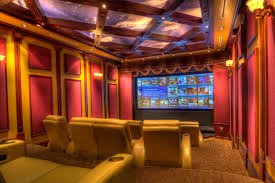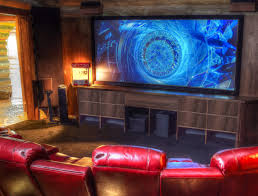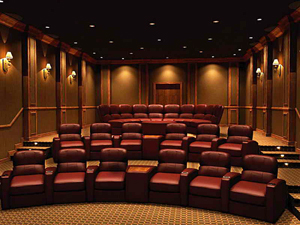|
While it may look effortless, home theater design can be tricky. Getting a media room that has both the performance and aesthetics you desire isn't as simple as plopping a bunch of gear into a room and hitting play. It's a little more complicated than that. The idiosyncrasies of audio and video, room peculiarities, and cumbersome equipment conspire against you, presenting design challenges that, with a little savvy and perhaps a drill, you can easily overcome. If you are just getting started on your own media room or home theater, here are a few design and technical tips to dial in your room of magic. Video Placement
You're ready for a home theater set-up, and you're quivering with anticipation at the thought of a fully immersive movie experience right in your own home. But there's that one nagging question: Where do you begin? There are so many variables to consider, both technical and financial. Consider, for example, that a home theater can set you back anywhere from $1,000 to $25,000 — and more. Or that Amazon lists more than 700 possibilities for home theater speakers. With so many options, rigging up your home theater can be a head-spinning exercise. But take heart. Even the most non-tech-savvy home theater newbie can do a whole lot to maximize their home theater experience, no matter what the price range. Here's what you need to know. THE ROOM Most likely, you know where you'll locate your set-up. It might be the main living area, a spare bedroom or a basement movie palace complete with a popcorn machine. While each of these spaces has special considerations in terms of comfort and sound quality, there are many common factors. • Room shape. Square rooms tend to produce odd harmonic distortions. If you have the choice, opt for a rectangular room, and plan to place your display screen and main speakers along a short wall for best sound projection. • Windows. The fewer, the better. Windows are a double bugaboo: They're hard surfaces that reflect sound-causing audio distortion, and they admit light that can produce reflections on your viewing surface. Heavy curtains and shades help, but that means closing blinds or drapes every time you turn on your home theater system. If you must, opt for blackout-style window treatments that track tight against window jambs to seal out light. • Walls. If you're tempted to staple inverted egg cartons all over your walls to muffle sound, relax. Regular drywall is a decent surface appropriate for home theater walls. However, break up large flat surfaces with furniture or drapes. Don't add framed art with glass — it's too reflective of sound and light. Concrete or concrete block is simply a no-no. If you're setting up in a basement with concrete walls, consider installing studs and drywall. Other options include acoustic wall panels designed specifically for home theaters. These panels are called "sound absorption" panels, and they help modulate low and high frequencies, preventing echoes. Panels come as 1' x 1' or 2' x 2' squares costing $4 to $20 per square foot. At $2 to $4, peel-and-stick carpet tiles are the budget-minded alternative. You just don't want to end up with a room that looks like Lloyd and Harry's shaggy van from Dumb and Dumber. Remember sound abatement cuts both ways. Controlling the sound in your home theater room means peace and quiet for the rest of your house. • Flooring. Wall-to-wall carpet, with a new cushy pad underneath, absorbs ambient sound and contributes to coziness. Kids like to sprawl on the floor to watch stuff, and you never know when some romantic comedies might get you and a loved one rolling on the carpet. With laughter, of course. • Wall/room color. Paint your walls as dark as you can stand them: Bright colors reflect light that's especially distracting when there's a brightly lit scene on the screen. Stay away from gloss or semi-gloss sheens, choosing reflection-fighting eggshell or flat paint instead. Go with neutral browns, tans and olive. Stronger colors, such as red and blue, will give an odd cast to any ambient light and may affect the colors you see on your screen. . Determining your maximum number of seating rows for your home theater is affected by the amount of space available and by your screen size (the size or your screen width relative to your theater seat size). Again there is a basic rule you can use to determine your optimal maximum seating. You simply divide your screen width in inches by 30. Round the number to the nearest integer. Your answer will determine the maximum number of rows you can have according to your screen size (corresponds to standard size theater seats). In order to the get the best theater-quality picture from your TV, you may want to have it calibrated. These calibrations could include adjusting your grayscale. If you purchased your TV at a specialty retail store, the store may be able to give you names of professionals who can calibrate your TV for you. Some retail stores even include the price of TV calibration in the purchase price of your TV. Another option is to use an independent contractor to do the calibration. If this is the option you desire, try to find a contractor who is certified by the Imaging Science Foundation and who owns their own equipment. SoundSpeaker technology is wonderfully advanced, and competition among top speaker manufacturers has helped turn home theater sound reproduction into a fine art. Which means a system you choose for your home theater is likely to be of very high quality. Most home theater speaker systems (and movie soundtracks) are designed to provide specific sounds from specific areas of your listening environment. When a train goes thundering through a scene, you hear the sound move from one side to the other. However, speakers labeled as bipole or dipole aren't compatible with this essential feature of home theater, so check before you buy. • Speaker placement. A typical home theater features 5.1 surround sound, meaning there are five full-range speakers and one low-range specialist, the woofer. You'll place three speakers and the woofer toward the front of the room, and the two remaining speakers on either side and slightly behind your viewing position. Keep speakers at least 20 inches from walls. Let's not forget that each room is unique, and the best sound for you may come only after experimenting with speaker placement. Fortunately, speakers are moveable. • Ideal distance. In a perfect world, your ears would be equidistant from each speaker. Given that your ears are on opposite sides of your head, it's safe to say you won't ever achieve this kind of perfection. Nevertheless, come as close to the goal as you can. Some speakers — certainly your woofer — will have individual volume controls you can tweak. More sophisticated speakers provide millisecond adjustments, called delays, that time sound projection from each speaker so that everything arrives in your ears at precisely the same instant, a handy feature for large rooms with speakers at various distances. Audioholics Online A/V Magazine even gives a formula: a 1 millisecond delay equates to 1.1 feet of distance. A speaker 5.5 more feet away from your head than your other speakers would require an advance setting of 5 milliseconds. • Playing center field. Of all your speakers, your center front speaker is perhaps the most influential. It bears the responsibility of projecting sound directly from the screen. This is especially important for dialogue — you don't want to see the actors talking in front of you while the sound of their voices is coming from the side. Sometimes overshadowed by a pair of sexy tower speakers flanking it, the center speaker shouldn't be downgraded in your home theater budget. Spend time adjusting your center speaker so that dialogue seems to come directly from your display. • Woof, woof. Your woofer goes up front, but there's usually only one, so you have to decide which side. The low bass ranges reproduced by a woofer will permeate the room, so angle is less important than with other speakers. A corner location helps distribute your woofer's sound evenly but, as with all components, experiment with different positions before settling on the ideal location. Remember sound from a subwoofer is non directional and can be felt (heard) from almost any angle.
Speaker placement is a integral part of any home theater experience. There are at least five speakers involved in any home theater sound system. They include: front left and right speakers, two surround speakers, and the center channel speaker. There can also be a sub woofer or LFE speaker. Some high end systems use 7 speakers or more including 2 sub woofers to get deep bass sounds through out the entire room. In order to get the surround sound that you desire, there are specific spots in a room where the various speakers must be placed to produce the different sounds. Room acoustics will differ though, and different speakers respond differently. Manufacturers of speakers typically offer recommendations on speaker placement, so you must consider their advice in addition to the advice of this article. Sound Placement Continued....The center channel speaker is completely dependent on your TV screen's placement. Its job is to anchor dialogue and various on-screen sounds to the screen. This speaker usually carries 40-60 percent of the sound produced for your room. You will adjust your left and right front speakers so their sounds will blend with sound from the center speaker. The placement for the center channel speaker is centered on the top or directly below the TV screen. If you have a front projection configuration, the center channel speaker should be placed behind the acoustically transparent screen approximately six to 12 inches away. The center speaker tweeter should be at ear level when you are seated (with a rear projection or direct view TV it is best to place it on top of the TV screen). Some tips for the center channel speaker include: align the front edge of the speaker precisely with the front edge of your TV, point the speaker directly at your primary audience, and the center speaker should be the exact same distance from the listening seats as the two front speakers. The left and right front speakers carry the majority of the music and sound effects. They should be placed at equal distances on each side of your TV. The two speakers should be at least six inches apart. If group viewing is the theme for your home theater, the two front speakers and center channel speakers should all be in a parallel line with the front row of seats. The front left and right speakers need to enclose a 45 (for movies) to 60 (for music) degree angle with the center viewing position to truly give you the sound quality you seek. Viewing
The crown jewel of any home theater set-up is a high-definition display screen. The temptation is to equate size with increased viewing pleasure, but there are limits. You want an immersive experience, but not a display so big you're swinging your head from side to side in an effort to take in all the action. You're looking for the right combination of display size and viewing angle. Optimum angle. HDTV manufacturers and home theater experts place the best viewing angle between 30 to 40 degrees. Meaning, if you would draw a triangle from the edges of the display to your nose, the angle of the apex (the angle that points at your head) would be 30 to 40 degrees. This lets you take in all the action with minimal, comfortable eye movement. Note that if you stay the same distance from your display but move off to the side, the viewing angle gets narrower. If you plan to have multiple seating, make sure all chairs have an optimum viewing angle. Optimum distance. Ideal viewing angle can be expressed simply as distance, too, usually 1.5 to 2.5 times the diagonal width of your screen. That means you should sit no closer than 7.5 feet from a 60-inch-wide TV, and no more than 12.5 feet away. A viewing distance calculator can help when math skills falter. This formula works in reverse, too. If you know your viewing distance — say it's 8 feet — then you can select an optimum display size. Eight feet is 96 inches. Divide by 2 (a nice round average of 1.5 and 2.5) and you'll get 48 inches. So a good HDTV display for your viewing distance would be about 48 inches wide (measured diagonally). Viewing height. The best viewing height is to have the center of the display screen at eye level. While that might seem elemental, some folks are tempted to elevate the display so that it lords above their theater set-up. If you do elevate your display, tilt it so that it faces your seating area. If your seats recline so that you're square to the display, so much the better. And don't forget to elevate your center speaker, too. When Bogart says, "Here's looking at you, kid," you don't want it to seem as if he's talking out of the side of his mouth. There are many important factors that combine to provide home theater viewers with incredibly realistic viewing. The previously mentioned considerations are at the top of the importance list, but there are also other important factors such as home theater lighting and seating. Screen and speaker placement were discussed in-depth because they come first in the creative process. The other factors revolve around them.
Key Resources for Home Theater Design:
|














